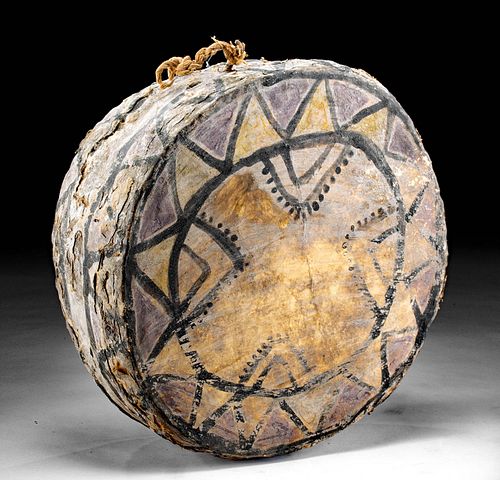Rare Nazca Polychrome Wood and Hide Tinya Drum
Lot 102
About Seller
Artemis Fine Arts
686 S Taylor Ave, Ste 106
Louisville, CO 80027
United States
Selling antiquities, ancient and ethnographic art online since 1993, Artemis Gallery specializes in Classical Antiquities (Egyptian, Greek, Roman, Near Eastern), Asian, Pre-Columbian, African / Tribal / Oceanographic art. Our extensive inventory includes pottery, stone, metal, wood, glass and textil...Read more
Categories
Estimate:
$9,000 - $13,500
Absentee vs Live bid
Two ways to bid:
- Leave a max absentee bid and the platform will bid on your behalf up to your maximum bid during the live auction.
- Bid live during the auction and your bids will be submitted real-time to the auctioneer.
Bid Increments
| Price | Bid Increment |
|---|---|
| $0 | $25 |
| $300 | $50 |
| $1,000 | $100 |
| $2,000 | $250 |
| $5,000 | $500 |
| $10,000 | $1,000 |
| $20,000 | $2,500 |
| $50,000 | $5,000 |
| $100,000 | $10,000 |
| $200,000 | $20,000 |
About Auction
By Artemis Fine Arts
Mar 4, 2021
Set Reminder
2021-03-04 10:00:00
2021-03-04 10:00:00
America/New_York
Bidsquare
Bidsquare : Ancient | Ethnographic Art Through The Ages
https://www.bidsquare.com/auctions/artemis-gallery/ancient-ethnographic-art-through-the-ages-6467
Ancient art from Egypt, Greece, Italy and the Near East, as well as Asian, Fossils, Pre-Columbian, Native American, African / Tribal / Oceanic, Fine art, and much more! All categories, all price ranges... all legally acquired and guaranteed to be as described or your money back. Artemis Fine Arts info@artemisfinearts.com
Ancient art from Egypt, Greece, Italy and the Near East, as well as Asian, Fossils, Pre-Columbian, Native American, African / Tribal / Oceanic, Fine art, and much more! All categories, all price ranges... all legally acquired and guaranteed to be as described or your money back. Artemis Fine Arts info@artemisfinearts.com
- Lot Description
Pre-Columbian, South Coast Peru, Nazca culture, ca. 100 BCE to 1000 CE. A rare and impressive double-sided drum, known as a tinya, boasting a cylindrical form constructed with two branches bent into circles, tied with vegetal fiber rope to a wooden border, and wrapped in hide. Petite wooden spikes line the walls of the interior, allowing the hide to not sink inward, while the drum remains hollow. The tan-colored hide exterior of the ancient instrument is intricately painted with a series of abstract designs in vibrant hues of marigold, maroon, silver and black. One batter head is adorned with a decorative sun motif containing a double-bordered "x" with a series of dashes inscribed along its inner edge. Alternatively, the other side is embellished with a black grid design displaying squares painted in alternating shades of red and yellow. Two horizontal registers of triangles divided by a central solid band decorates the periphery of the ancient instrument. Used primarily by women, tinyas, such as this example, were typically wrapped in the hide of a camelid, though, in some cases, the human skin of vanquished enemies would be used instead. Size: 13" in diameter x 5" H (33 cm x 12.7 cm)
The indigenous cultures of the Andes have incorporated rhythms and harmonies in ceremonial rituals, dances, theatrical events, and even warfare since the Pre-Columbian era. Instruments were often used by the Andean peoples to communicate with the ancestors, heal the sick, and bury the dead. Sculptural homages to musicians and dancers throughout Andean cultures as well as detailed accounts written by Spanish chroniclers of the 16th century provide ample evidence of the importance of music and instruments to the ancients of the Andes.
According to the Metropolitan Museum of Art's article "Music in the Ancient Andes" by Helene Bernier, "Archaeological investigations suggest that Nazca musical instruments were important ritual objects used during group performances at the ceremonial center of Cahuachi. They were also likely played during processions along the great Nazca geoglyphs, which were suitable to be used as ritual pathways."
Provenance: private Hawaii, USA collection; ex-private Hans Juergen Westermann collection, Germany, collected from 1950 to 1960s
All items legal to buy/sell under U.S. Statute covering cultural patrimony Code 2600, CHAPTER 14, and are guaranteed to be as described or your money back.
A Certificate of Authenticity will accompany all winning bids.
We ship worldwide and handle all shipping in-house for your convenience.
#162557Collection label on side. Slight warping to wooden periphery in small area causing fissure between leather face and wooden side. Light wear to hide, especially on periphery. Otherwise, excellent with impressive remaining pigments.Condition
- Shipping Info
-
All shipping is handled in-house for your convenience. Your invoice from Artemis Gallery will include shipping calculation instructions. If in doubt, please inquire BEFORE bidding for estimated shipping costs for individual items.
-
- Buyer's Premium



 EUR
EUR CAD
CAD AUD
AUD GBP
GBP MXN
MXN HKD
HKD CNY
CNY MYR
MYR SEK
SEK SGD
SGD CHF
CHF THB
THB











